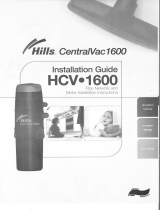
5
TOOL LISTING
Depending on your installation, you may require the use of these tools. The power tools are recommended to make your installation
proceed quickly. Also, plan a mask when cutting ducting (PVC dust) and gloves when using glue.
• Wire Strippers • 1/4" Drill • Level • Flashlight
• Utility Knife • Putty Knife • Drill Bit • Electrical tape
• Knife • Hammer • Screwdriver • Safety Glasses
• 2½" Hole Saw • Keyhole Saw • Wrench • Hacksaw
• 1/2" Drill • Cold Chisel • Tape Measurer
SYSTEM PLANNING AND LAYOUT (CONT'D)
LOCATING THE POWER UNIT
• Locate the power unit away from the general living area in
an accessible location for cleaning and maintenance.
• When planning the installation of PP650 power unit,
remember it is equipped with an inlet to service a garage,
basement, utility room, etc., wherever it is located.
• Locate the power unit within 6 feet of a grounded electrical
outlet. The power unit requires a 120 VAC power source.
• Do not locate the power unit close to a source of extreme
heat (i.e.: water heater) or in an area with a high ambient
temperature (i.e.: attic, furnace room).
• If the power unit is located in a closet or a small utility
room, make sure the area is well-ventilated (e.g.: with door
louvers).
• Exhausting the power unit to the outside is recommended
for optimal performance. The exhaust should not be vented
into a wall, a ceiling or a concealed space in the house.
The exhaust line should be vented outside the home using
a Model 393 or CI330 wall caps.
TUBING AND
WALL INLET LOCATIONS
Locate inlets on interior walls, choosing central locations
which allow several rooms to be cleaned from a single inlet
using a 30-foot long hose.
The tubing installation should consist of a main trunk line
running from the farthest wall inlet to the power unit location,
with branch lines running to each additional inlet. Keep all
tubing lines as straight as possible and use as few fittings as
possible.
Beginning at the area farthest from the power unit, choose
a tentative inlet location. Measure 30 feet from the proposed
inlet location to the farthest corner of the rooms to be cleaned
by that inlet to determine if inlet location is proper. If working
from blueprints (or building plans drawn at 1⁄4" = 1 ft. scale),
use a 7½" chain as your guide to determine inlet locations.
Locate inlets within six feet of an electrical receptacle to
allow use of optional current-carrying hose.
Be sure inlets will not be blocked by doors or furniture.
Be sure inlets will not interfere with electrical, plumbing or
other mechanical installations.
Move tentative inlet location if necessary. Use the same
procedure to determine each additional inlet location,
always working toward the power unit.
WARNING
Do not install outdoors. When performing
installation, servicing or cleaning the unit, it is
recommended to wear safety glasses and gloves.
GENERAL INSTALLATION GUIDE
WARNING
When applicable local regulations comprise more restrictive installation and/or certification requirements,
the aforementioned requirements prevail on those of this document and the installer agrees to conform to
these at his own expenses.
WORKING WITH PLASTIC TUBING
CUTTING THE TUBING
Before you cut a length of tube,
accurately measure the length you
need. Allow 5/8” of tubing for inserting
into fittings and 1½” for placing into
flexible tubing. Cut the plastic tubing
with a hacksaw, making sure that the
cut is exactly square. (You can use a
tube cutter if one is available.) Use
wire cutters or tin snips to cut flexible
tubing. The 8” lengths of flexible tubing
supplied with each inlet should not be
cut. See figure at right.
Use a small knife to remove any burrs
from the inside of the tube. You can
also use steel wool to remove burrs.
The burrs must be removed or they
may impede air flow of form clogs by
snagging hair and carpet thread. See
figure at right.
AR0016
AR0017




















